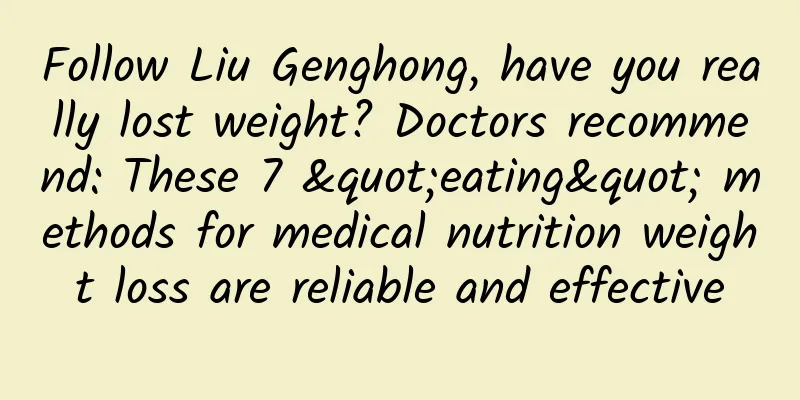Follow Liu Genghong, have you really lost weight? Doctors recommend: These 7 "eating" methods for medical nutrition weight loss are reliable and effective

|
If you don't lose weight in March, you will regret it in April If you don't lose weight in April, you will regret it in May If you don’t lose weight in May, June… No longer sad, but heartbroken... The weather is getting warmer, and it’s the perfect season to lose weight. The most popular girls right now are “Liu Genghong girls”. How many citizens followed the practice and waited for Teacher Liu to "mark their homework" every day? But have you really lost weight? Some people have indeed succeeded! Some people were seriously injured! It seems that not everyone is suitable to follow Liu Genghong. Blindly pursuing high-intensity, overloaded exercise, Maybe it will be effective in a short period of time. But if you give up halfway due to sports injuries, It would be even more heartbreaking if it rebounds in the future and forms a vicious cycle! Therefore, to lose weight scientifically and effectively, you need to start with your overall lifestyle under the guidance of professionals, follow evidence-based medicine guidelines, and develop a comprehensive and scientific weight loss plan. While exercising, you must also control your diet and persevere to achieve your ideal weight loss goal. 7 intervention methods for medical nutrition weight loss 1. Energy Limit An energy-restricted diet is a dietary pattern that reduces total energy intake based on a balanced dietary pattern. The total energy intake of an energy-restricted diet generally reduces energy intake by 500 to 1000 kcal per day on the basis of the target energy intake, or reduces total energy by 1/3 compared to the recommended intake, of which carbohydrates account for 55% to 60% of the total daily energy, and fat accounts for 25% to 30% of the total daily energy. Energy-restricted diet is an effective weight management method that can reduce the weight of obese people, reduce body fat content, improve metabolism, and reduce the risk factors of cardiovascular disease. It is easy to stick to for a long time and is highly safe. 2. High Protein A high-protein diet increases the proportion of high-quality protein in the diet while limiting total energy intake. A high-protein diet usually contains more than 20% of total daily energy or 1.5 g/(kg·d) of protein per day, but generally does not exceed 30% of total daily energy or >2.0 g/(kg·d). Studies have shown that compared with conventional protein diets, high-protein diets can significantly reduce weight and waist circumference. At the same time, it can increase satiety and reduce hunger, which helps to enhance the compliance of severely obese people with weight loss and maintain the weight loss effect. There are few studies on the long-term use of high-protein diets for intervention, so it is recommended that it be implemented under the guidance of a professional nutritionist, while strengthening clinical monitoring, including renal function, to ensure the safety of the program. 3. Low Carb Many people simply understand a low-carbohydrate diet as not eating staple foods at all, but this is actually a misunderstanding. A low-carbohydrate diet usually refers to a diet in which the carbohydrate energy supply ratio in the diet is ≤40%, the fat energy supply ratio is ≥30%, the protein intake is relatively increased, and the total energy intake is limited or not limited. Studies have shown that low-carbohydrate dietary intervention is beneficial for controlling weight, improving metabolism and controlling blood sugar, but its long-term safety and effectiveness are still unclear. In addition, due to the limitations of food choices, the intake of dietary fiber, calcium, iodine, magnesium, zinc and iron is easily lower than the recommended intake. Therefore, it is not recommended for children and adolescents to implement it for the purpose of weight loss in the long term. 4. Meal Replacements Meal replacement foods are energy-control foods that are specially processed and formulated to meet the nutritional needs of one or two meals for adults during weight control and to replace part of the meals. Many studies have shown that the use of meal replacement foods is beneficial for weight loss and improving the risk factors for obesity-related diseases, such as hyperlipidemia and hyperglycemia. During the weight loss period, it is recommended to choose meal replacement foods that meet the group standards of the Chinese Nutrition Society, combined with multivitamin and mineral supplements to ensure adequate nutrition during the weight loss period. The short-term use of meal replacement foods for weight loss is safe, with few serious adverse reactions and good tolerance. It can improve blood sugar in diabetic patients by reducing weight and reduce the risk factors for cardiovascular events in patients with metabolic syndrome and cardiovascular disease. However, the long-term safety and effectiveness of meal replacement foods still need to be confirmed by more research. 5. Intermittent fasting Many people who are keen on losing weight must have heard of Carina Lau and Andy Lau's "intermittent fasting" weight loss method, which involves fasting for 16 hours a day and eating whatever they want during the other 8 hours. In fact, this concept comes from the time-restricted eating method. Time-restricted eating refers to a diet that restricts the time of eating each day and fasts for 3 to 21 hours, either during the day or at night. There are three common types of fasting: 4 hours, 6 hours, and 8 hours. Some studies have shown that short-term intervention with time-restricted eating can reduce weight, but the results on its effects on body composition, insulin resistance, and lipid metabolism are inconsistent, and there is currently insufficient effective evidence for its long-term effects on weight loss. In addition, there is intermittent energy restriction, which is a dietary pattern of fasting or giving limited energy intake during a specified period of time according to a certain regularity. Currently commonly used methods include the alternate-day method, 4:3 intermittent energy restriction or 5:2 intermittent energy restriction (continuous/non-continuous fasting for 2 to 3 days per week). Compared with conventional diet, intermittent energy restriction intervention can reduce the weight of overweight/obese people, improve lipid metabolism indicators, and has a relatively low incidence of adverse events. However, some studies have shown that compared with continuous energy restriction, the advantages of intermittent energy restriction are not obvious, and there is no significant difference in the weight loss effect of several different types of intermittent energy restriction. 6 Low glycemic index diet Low glycemic index foods have low energy and high dietary fiber characteristics, which can relax gastrointestinal tolerance, increase satiety, and help reduce total energy intake. They can reduce postprandial blood sugar peaks, reduce blood sugar fluctuations, the speed and amount of insulin secretion, thereby reducing postprandial blood sugar and insulin response, promoting fatty acid synthesis and storage, preventing fat mobilization and decomposition, reducing free fatty acid levels and antagonizing hormone responses, and increasing insulin sensitivity. A low-glycemic index diet that restricts total energy can reduce weight in obese people, and its short-term weight loss effect is better than that of a high-glycemic index diet. 7 Dietary Patterns The Diet to Stop Hypertension, as the name suggests, is a dietary approach originally studied for lowering blood pressure, stemming from a 1997 study published in the New England Journal of Medicine. The diet to end hypertension emphasizes increasing the intake of vegetables, fruits, low-fat (or skim) milk and whole grains, reducing the intake of red meat, oils, refined sugar and sugary drinks, eating appropriate amounts of nuts and beans, thereby providing rich minerals such as potassium, magnesium, calcium and dietary fiber, increasing the intake of high-quality protein and unsaturated fatty acids, and reducing the intake of fat, especially saturated fatty acids and cholesterol. Several randomized controlled studies have shown that compared with a conventional diet, a diet to end hypertension can effectively reduce the body mass index and body fat content of overweight/obese people. Some studies have also shown that it can significantly reduce insulin levels in overweight/obese people. The Mediterranean diet is characterized by being mainly composed of plant-based foods, including whole grains, beans, vegetables, fruits, nuts, etc.; moderate amounts of fish, poultry, eggs, and dairy products, and small amounts of red meat and its products; the main edible oil is olive oil; drinking red wine in moderation, and a high intake of unsaturated fatty acids. There is ample evidence that the Mediterranean diet is effective in reducing body weight compared with a usual diet in overweight/obese individuals, those with diabetes and metabolic syndrome, and postpartum women. In addition to the above-mentioned common "eating" methods, medical nutrition weight loss should also pay special attention to micronutrient supplementation and intestinal microecological balance. Of course, the currently popular Internet-based mini-programs/mobile phone applications that use online nutrition knowledge theory teaching, mutual assistance, follow-up, supervision, and provide relevant advice on nutrition and exercise are also effective means of medical nutrition weight loss. In short, medical nutrition weight loss requires scientific "control of diet", as for "moving legs", here we have compiled for you the expert advice from the "Guidelines for Medical Nutrition Treatment of Overweight/Obesity in China (2021)": Overweight/obese individuals should perform at least 150 minutes of moderate-intensity exercise per week to achieve moderate weight loss. To achieve a weight loss of ≥ 5% of body weight, the weekly exercise time should reach 300 minutes, and the exercise intensity should be moderate to high intensity or the exercise energy expenditure should reach 2000 kcal or more per week. ▌The topic of this article comes from the "Journal of Peking Union Medical College", the interpretation of the 2022 issue 2 of the "Guidelines for Medical Nutritional Treatment of Overweight/Obesity in China (2021)" ▌Original author: Sun Mingyao, Chen Wei Editor: Liu Yang and Zhao Na Proofread by Li Na, Li Yule, and Dong Zhe Producer: Wu Wenming Copyright Notice: PUMCH Medical Journal advocates respecting and protecting intellectual property rights. Reprinting and quoting are welcome, but authorization is required. If you have any questions about the copyright of the article, please send an email to [email protected] and we will communicate with you in a timely manner. The content and pictures on this website are for reference and learning purposes only, not for profit and are not used as a basis for diagnosis or medical treatment. |
<<: Nature: This century-old problem was perfectly solved by "it" in 48 hours
Recommend
Product and user operation method system (I)
As an operator, we constantly optimize the intera...
The automotive industry is uneasy due to the double points policy for passenger cars
Recently, the "Measures for the Parallel Man...
New Energy Vehicle Channel Development in 2022-2023
On March 30, 2023, the 2022 Automobile Distributi...
Tik Tok account homepage design guide
1. Why should we pay attention to the homepage de...
How to write advertising copy? 50 classic movie lines, 50 examples!
For a crazy movie collector sometimes "One l...
Parents are addicted to mobile phones, which only brings harm, so should we confiscate their phones?
gossip "Old people's 'addiction'...
Private domain operation strategy for beauty brands!
Preface As the vanguard of the new brand wave, th...
It invades fishing grounds on a large scale and preys on shellfish. What is this "killer"?
Review expert: Ancient Mingdi Lian (He Lin) Zhihu...
How can common goods be sold at 10 times the price in Douyin live broadcast room?
If you are an aspiring merchant, you should not b...
Case solved! Scientists solve the mystery of pyramid construction: how the huge stones were transported
The Step Pyramid of Djoser, built during the Thir...
From the “big characters” that flood the friend circle, let’s look at the 7 logics behind the article being forwarded!
Last Friday, everyone suddenly discovered that a ...
That day | 30 years ago, a major national weapon was named "Xuelong"
On December 7, 1992, Wu Heng, former director of ...
Is such a "happy" holiday really good for children? - Focus on childhood obesity
Author: Huo Liang, Associate Professor, Shengjing...
Don’t know how to do operational review? This is the clearest tutorial ever!
In addition to copying and pasting, I am also inv...
Peng Xinrong's "The Art of Naming" Baidu Cloud Download
Course Catalog: 01. The Art of Naming Lecture 1.m...









